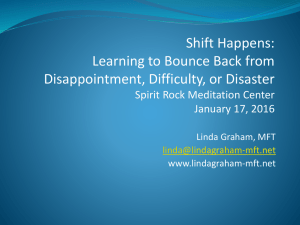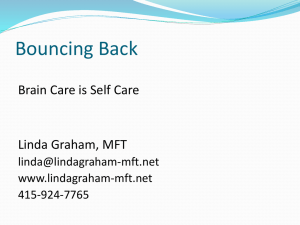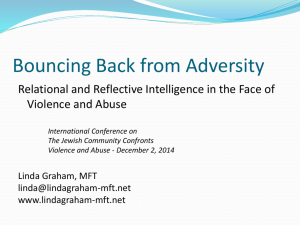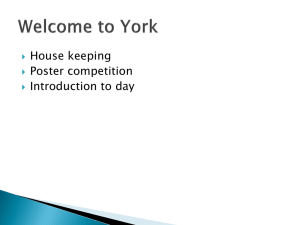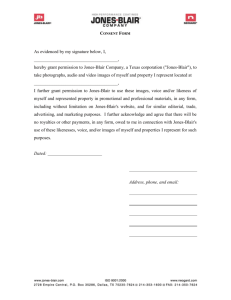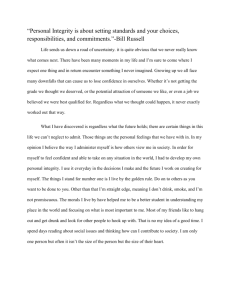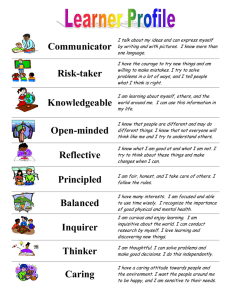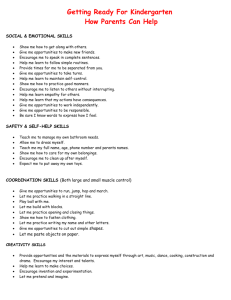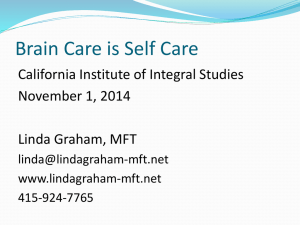presentation as PowerPoint slides
advertisement
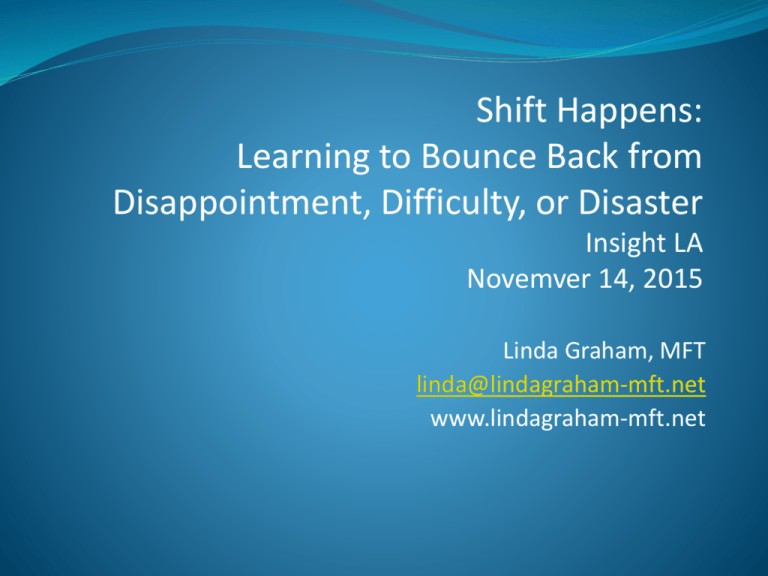
Shift Happens: Learning to Bounce Back from Disappointment, Difficulty, or Disaster Insight LA Novemver 14, 2015 Linda Graham, MFT linda@lindagraham-mft.net www.lindagraham-mft.net Linda Graham, MFT Marriage and Family Therapist – 25 years Psychodynamic, Attachment, Trauma, Mindfulness, Neuroscience Meditation, Mindful Self-Compassion teacher Bouncing Back: Rewiring Your Brain for Maximum Resilience and Well-Being 2013 Books for a Better life award 2014 Better Books for a Better World award linda@lindagraham-mft.net www.lindagraham-mft.net Affectionate Breathing Sit comfortably; breathe slowly and gently. Incline your awareness toward your breathing with tenderness and curiosity Let the body breathe itself; notice the natural nourishing and soothing of the body Feel the whole body breathe Allow the body to be gently rocked by the breath Savor the stillness and peace in the body Shift Happens Shit happens Shift happens, too Shift can happen in this moment Shift can happen in any moment That’s the shift Shift Shift brain functioning in the moment Shift responses to experience over time Abide in a new way of being Mindfulness Pause, become present, focus attention Notice and name experience Practice self-compassion for whatever we are noticing; shift brain functioning Step back, reflect, inquire Shift perspective, view Discern options, choose wise action Imagine walking down the street Notice someone you know walking toward you Wave “hello!” There’s no response. Notice your response to the lack of response The person notices you and waves “hello!” Notice your response to the response Notice any differences in your responses Autobiography in Five Short Chapters – Portia Nelson I I walk down the street. There is a deep hole in the sidewalk I fall in. I am lost…I am helpless It isn’t my fault. It takes me forever to find a way out. II I walk down the same street. There is a deep hole in the sidewalk. I pretend I don’t see it. I fall in again. I can’t believe I’m in the same place But, it isn’t my fault. It still takes a long time to get out. III I walk down the same street. There is a deep hole in the sidewalk. I see it is there. I still fall in…it’s a habit My eyes are open, I know where I am. It is my fault. I get out immediately. IV I walk down the same street There is a deep hole in the sidewalk. I walk around it. V I walk down another street. -Portia Nelson Self-Compassion May I be kind to myself in this moment May I accept this moment, exactly as it is May I accept myself in this moment, exactly as I am May I give myself all the compassion I need Hand Gestures of Self-Compassion Fists closed Palms open, facing upward Palms extended and forward Palms placed over heart Self-Compassion Break Notice moment of suffering, or inquire: “Is there any suffering here?” Ouch! This hurts! This is painful. Soothing touch (hand on heart, cheek, hug) Common humanity: I’m not alone; I’m not the only one Kindness toward experiencer May I be kind to myself in this moment May I accept this moment exactly as it is May I accept myself in this moment exactly as I am May I give myself all the compassion I need to respond to this moment wisely Mindfulness and Compassion Activate Caregiving System Mindfulness Focuses awareness on experience May I accept this moment, exactly as it is Self-Compassion Focuses kindness on experiencer May I accept myself exactly as I am in this moment Common Humanity I am not alone; I am not the only one Activates caregiving system Shift from reactivity and contraction to openness, engagement Benefits of Self-Compassion Increased motivation; efforts to learn and grow Less fear of failure; greater likelihood to try again Taking responsibility for mistakes; apologies and forgiveness More resilience in coping with life stressors Less depression, anxiety, stress, avoidance Healthier relationships; more support and, less control and/or aggression Increased social connectedness, life satisfaction, and happiness Soles of the Feet Stand up; feel soles of feet on the floor Rock back and forth, rock side to side Make little circles with your knees Lift each foot; place back down Walk slowly; notice changes in sensations Offer gratitude to your feet that support your entire body, all day long Conditioning Experience causes neurons to fire Repeated experiences, repeated neural firings Neurons that fire together wire together Strengthen synaptic connections Connections stabilize into neural pathways Without intervention, is what the brain does Conditioning is neutral, wires positive and negative The brain is shaped by experience. And because we have a choice about what experiences we want to use to shape our brain, we have a responsibility to choose the experiences that will shape the brain toward the wise and the wholesome. - Richard J. Davidson, PhD New Conditioning Choose new experiences Focused attention, compassionate listening, gratitude practice Create new thoughts, new experience of self Create new learning, new memory Encode new wiring Install new pattern of response, new habits, new ways of being Shift from Self-Critical Voice to Self-Compassionate Voice Loving awareness of breathing Let a moment of discomfort arise; notice where you feel in the body Notice any critical self-talk; notice the words; notice the tone of voice Use critical voice as cue to practice: “May I be kind to myself in this moment; may I accept myself in this moment exactly as I am.” Re-conditioning Memory de-consolidation – re-consolidation “Light up” neural networks Juxtapose old negative with new positive Neurons fall apart, rewire New rewires old Re-Conditioning Resource with memory of someone’s compassion toward you Evoke compassion for your self Evoke memory of someone being critical of you (or inner critic) Hold awareness of criticizing moment and compassionate moment in dual awareness Drop the criticizing moment; rest in the compassionate moment. Modes of Processing Focused Attention Tasks and details Deliberate, guided change New conditioning and re-conditioning De-focused Attention Default network Mental play space – random change De-conditioning De-Conditioning Default network De-focusing, loosens grip of attention Creates mental play space, free association Can drop into worry, rumination Can drop into plane of open possibilities Brain makes new links, associations New insights, aha!s new behaviors De-Conditioning Reverie, daydreams Imagination Guided visualizations Guided meditations Brain “plays,” makes own associations and links, connect dots in new ways Reflect on new insights Compassionate Friend Sit comfortably; hand on heart for loving awareness Imagine safe place Imagine warm, compassionate figure – Compassionate Friend Sit-walk-talk with compassionate friend Discuss difficulties; listen for exactly what you need to hear from compassionate friend Receive object of remembrance from friend Reflect-savor intuitive wisdom Sense and Savor Walk Find a quiet place in nature; walk slowly Notice colors, shapes, sounds, smells Linger and savor, repeat Notice state of being Post-Traumatic Growth 75% Americans will experience potentially traumatizing event at least once in lifetime 8% will develop PTSD More than 50% will fully recover, finding meaning, deepening sense of self, stronger ties to community and common humanity Post-Traumatic Growth Acceptance of reality; create the new narrative Support from family; belief in recovery Community of “the tribe” Positive re-framing; positive meaning of negative event Helping others Appreciate new life because of catastrophe Intelligences Somatic: Body-based equilibrium Emotional: managing one’s own emotions and empathizing with others’; compassion Relational: connect, heal heartache, access resources, navigate peopled world Reflective: conscious awareness, mindfulness Hand on the Heart Touch – oxytocin – safety and trust Deep breathing – parasympathetic Breathing ease into heart center Brakes on survival responses Coherent heart rate Being loved and cherished Oxytocin – direct and immediate antidote to stress hormone cortisol Touch Hand on heart, hand on cheek Head rubs, foot rubs Massage back of neck Hold thumb as “inner child” Hugs – 20 second full bodied Calm through the Body Hand on the Heart Safe, soothing touch Body Scan Progressive Muscle Relaxation Soles of the Feet Rewiring through Movement Power Posing Mindful Self-Compassion Rewiring through Movement Body inhabits posture of difficult emotion (40 seconds Body moves into opposite posture (40 seconds) Body returns to first posture (20 seconds) Body returns to second posture (20 seconds) Body finds posture in the middle (30 seconds Reflect on experience Power Posing Amy Cuddy TED talk https://www.ted.com/talks/amy_cuddy_your_bo dy_language_shapes_who_you_are Before important meeting or interview: Stand tall and straight, like mountain pose in yoga Lift your arms in triumph or Place hands on hips (Wonder Woman) Kindness is more important than wisdom, And the recognition of that is the beginning of wisdom. - Theodore Rubin Doing a kindness produces the single most reliable momentary increase in well-being of any exercise we have tested. - Martin Seligman Take in the Good Notice: in the moment or in memory Enrich: the felt sense in the body Absorb: savor 10-20-30 seconds, felt sense in body Repeat: 6 times a day, install in long-term memory Increasing the social connections in our lives is probably the single easiest way to enhance our well-being. - Matthew Lieberman, UCLA Positivity Portfolio Ask 10 friends to send cards or e-mails expressing appreciation of you Assemble phrases on piece of paper Tape to bathroom mirror or computer monitor, carry in wallet or purse Read phrases 3 times a day for 30 days Savor and appreciate Then it was as if I suddenly saw the secret beauty of their hearts, the depths of their hearts where neither sin nor desire nor selfknowledge can reach, the core of their reality, the person that each one is in the eyes of the Divine. If only they could all see themselves as they really are. If only we could see each other that way all the time. There would be no more war, nor more hatred, no more cruelty, no more greed. …I suppose the big problem would be that we would fall down and worship each other. - Thomas Merton Brahma Viharas Loving Kindness Compassion Sympathetic Joy Equanimity Send and receive wishes to and from your partner True Other to the True Self The roots of resilience are to be found in the felt sense of being held in the mind and heart of an empathic, attuned, and self-possessed other. - Diana Fosha, PhD To see and be seen: that is the question, and that is the answer. - Ken Benau, PhD One for Me; One for You Breathing in, “nourishing, nourishing” Breathing out, “soothing, soothing” In imagination, “nourishing for me, nourishing for you, soothing for me, soothing for you” “One for me, one for you” Practice breathing “one for me, one for you” when in conversation with someone Caregiving with Equanimity Everyone is on his or her own life journey. I am not the cause of this person’s suffering, nor is it entirely within my power to make it go away, even if I wish I could. Moments like this are difficult to bear, Yet I may still try to help if I can. Shame De-Rails Resilience Shame is the intensely painful feeling or experience of believing we are flawed and therefore unworthy of acceptance and belonging. Shame erodes the part of ourselves that believes we are capable of change. We cannot change and grow when we are in shame, and we can’t use shame to change ourselves or others. - Brene Brown, PhD Love makes your soul crawl out of its hiding place. - Zora Neale Hurston Love guards the heart from the abyss. - Mozart Just that action of paying attention to ourselves, that I care enough about myself, that I am worthy enough to pay attention to, starts to unlock some of those deep beliefs of unworthiness at a deeper level in the brain. - Elisha Goldstein Reconditioning Anchor in present moment awareness Resource with acceptance and goodness Start with small negative memory “Light up the networks” Evoke positive memory that contradicts or disconfirms Simultaneous dual awareness (or toggle) Refresh and strengthen positive Let go of negative Rest in, savor positive Reflect on shifts in perspective Wished for Outcome Evoke memory of what did happen Imagine new behaviors, new players, new resolution Hold new outcome in awareness, strengthening and refreshing Notice shift in perspective of experience, of self Coherent Narrative This is what happened. This is what I did. This has been the cost. This is what I learned. This is what I would do differently going forward. Mastering the art of resilience does much more than restore you to who you once thought you were. Rather, you emerge from the experience transformed into a truer expression of who you were really meant to be. - Carol Orsborn
